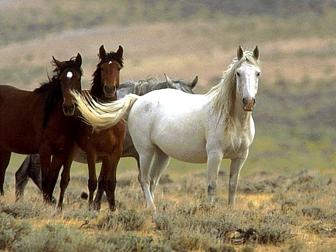
OVERVIEW
The Mustang descended from horses brought to the Americas by the Spanish Conquistadors over 400 years ago. In the 1500s, Spanish explorers and settlers moved into North America, bringing their horses with them. The Mustang descended from Spanish horses which either strayed, broke loose or were stolen from the explorers herds. These horses multiplied freely over hundreds of years on the open plains of the West. In 1834, for instance, 15,000 Mustangs were seen in the vicinity of an Indian camp in Texas. The Mustang's wild home gave it a tough and independent nature. Its hearty constitution made it an excellent horse for cowboys and some were even broken to pull stagecoaches.
PHYSICAL DESCRIPTION
The Mustang is a relatively small, hearty horse and since its breeding is not controlled, appears in various forms. Some are rough and unattractive; others are elegant and resemble their Oriental ancestors from Spain. They generally stand between 14 and 15 hands. Their coloring is various. Spotted colors are quite common, gurllo, a blue-gray color is often seen, as is buckskin, a dun color with black points. The Mustang is of uneven temperament and is very rugged.
ORIGIN
The Mustang is a descendent of Spanish horses brought to the Americas first by the Spanish in the early 1500s. As such, their ancestry traces back to Barb and Arabian horses brought to Spain by the Moors. The Mustang is found throughout the Western United States. The term "Mustang" is derived from the Spanish word mestena which means wild and free roaming.
INTERESTING FACTS
Spanish horses, the ancestors of the Mustang, thrived in the arid environment of the American West since it so clearly represented that of Spain and North Africa. The Spanish horses which escaped from captivity multiplied rapidly. The number of escaped horses was quite large. As early as 1596, for instance, the Spanish Governor of Santa Fe reported 300 horses and mules, one-fifth of the stock, had strayed while grazing. A century later, in 1690, General Alonzo De Leon lost 126 horses in East Texas. In 1691, a Spanish expedition lost another 135 horses. By the 1800s, one observer reported seeing 20,000 Mustangs grazing in the San Joaquin Valley of California.
INFLUENCES
1. Andalusian
2. Arabian
3. Barb
4. Turk
For more information:
American Mustang and Burro Association